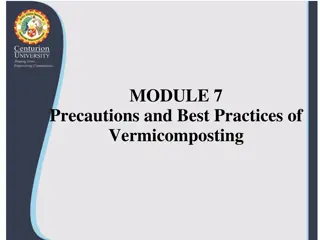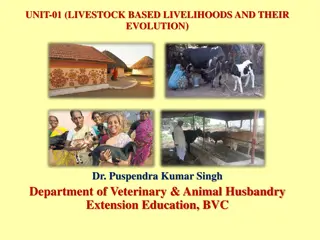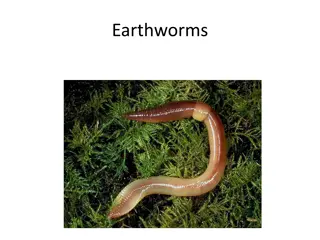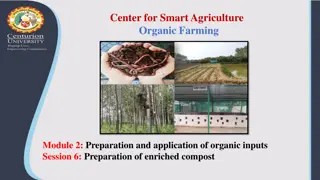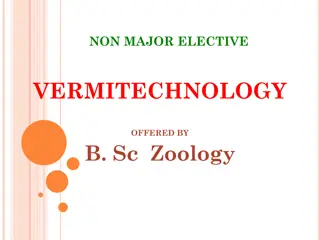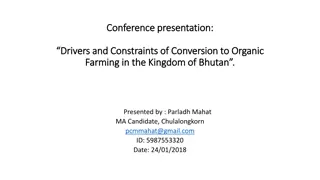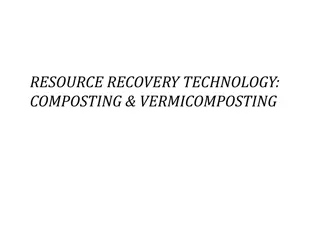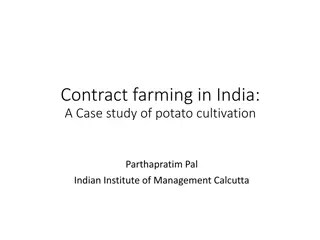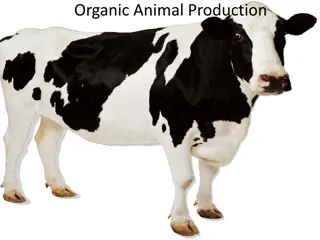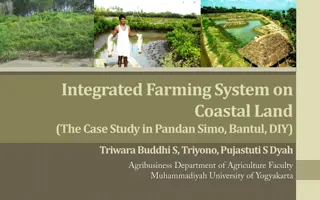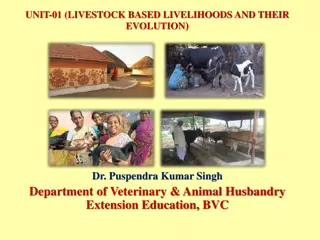Vermicomposting: Organic Farming with Earthworms
Vermicomposting is a sustainable method of converting organic waste into nutrient-rich compost using earthworms. This process involves preparing organic materials, creating a vermi bed, and layering substrates for the worms to decompose. Different earthworm species are utilized for vermicomposting, with specific steps to optimize compost production. By following proper techniques, vermicomposting can efficiently generate high-quality compost for organic farming practices.
Download Presentation

Please find below an Image/Link to download the presentation.
The content on the website is provided AS IS for your information and personal use only. It may not be sold, licensed, or shared on other websites without obtaining consent from the author.If you encounter any issues during the download, it is possible that the publisher has removed the file from their server.
You are allowed to download the files provided on this website for personal or commercial use, subject to the condition that they are used lawfully. All files are the property of their respective owners.
The content on the website is provided AS IS for your information and personal use only. It may not be sold, licensed, or shared on other websites without obtaining consent from the author.
E N D
Presentation Transcript
Center for Smart Agriculture Organic Farming Module 2: Preparation and application of organic inputs Session 7: Preparation of vermicompost
Vermiculture is the culture of earthworms. Vermicomposting is a method of preparing compost in which earthworms are used to convert organic materials (usually wastes) into a humus-like compost. Earthworms consume biomass and excrete it in digested form called worm-casts. The casts are rich in nutrients, growth promoting substances, beneficial soil micro flora and having properties of inhibiting pathogenic microbes.
Earthworm species There are nearly 3600 types of earthworms in the world and they are mainly divided into two types: (1) burrowing; and (2) non-burrowing. The burrowing types live deep in the soil. On the other hand, the non- burrowing typesconvert the organic waste into vermicompost faster. The earthworm species commonly used for vermicomposting are: Eisenia foetida(Red earthworm) Eudrilus eugeniae(African earthworm or night crawler) Perionyx excavatus (Composting earthworm)
Procedure of vermicomposting A. Preparation of organic wastes for vermicomposting Breaking of large lumps Cutting of bigger plant parts into smaller ones Exposing to sun to reduce excess moisture content Application of 4% aqueous solution of neem pesticides to kill insects, if any Treatment with lime dust to reduce pH Half decomposition of these materials is done by heaping the above mixture with sufficient moisture content for 21 days. (Contd )
B. Preparation of vermi bed Vermi bed is prepared by putting pebbles, sand and loamy soil one above the other is having 2 inches of thickness each at the bottom of the unit. Alternatively coir or any plant refuse which does not decompose easily can also be used. This should be watered followed by putting well decomposed FYM of 4 inches thickness over it. (Contd..)
C. Putting the substrates and composting Above the layer of FYM the half decomposed materials are to be kept to fill up the pit. Then the worms are released. When there are more number of pits, half decomposition can be done in some of them in which different materials can be put in layers till the pit is filled up and worms are to be released after the thermophillic stage of half decomposition is over. For a 2m X 1m X 0.6m (= 1.2 m3) tank 2 kg earthworms (2000 to 2500) are to be released. The number worms may be doubled when they are available in more quantities and compost is necessary to prepare within a month instead of normal time of 2 months. After filling up of the unit, it is to be covered preferably with an old wet gunny bag to reduce loss of moisture and encourage the activities of the worms at the surface. Intermediately the unit is to be watered to maintain moisture content of 40-50%.
D. Harvesting and post-harvest technologies Harvesting of vermicompost is done when the compost looks dark brown and soft. The compost is piled for 3-4 hours so that the worms go down and form a ball which can be separated for further use or selling the worms at premium price. After separation of worm balls, the compost should be dried under shed for reducing its moisture content to around 30%. The compost is passed through a sieve of 2-3 mm diameter so that the earthworm cocoons and the undecomposed materials could be separated for further use. Packaging and labelling can be done to attract the consumers for commercial production and at farmers level it can be kept in gunny bags. After completion of the process, the vermicompost should be removed from the bed at regular intervals and replaced by fresh partially decomposed organic materials.
E. Precautions during the process The following precautions should be taken during vermicomposting: The floor of the unit should be compact to prevent migration of earthworms into the soil. Only plant-based materials such as grass, leaves or vegetable peelings should be utilized in preparing vermicompost. Materials of animal origin such as eggshells, meat, bone, etc are not suitable for preparing vermicompost. Gliricidia loppings and tobacco leaves are not suitable for rearing earthworms. The organic wastes should be free from plastics, chemicals, pesticides and metals etc. 15-20 days old cow dung should be used to avoid excess heat. The earthworms should be protected against birds, termites, ants and rats. Adequate moisture should be maintained during the process. Optimum moisture level (30-40 %) and 18-25oC temperature should be maintained.





